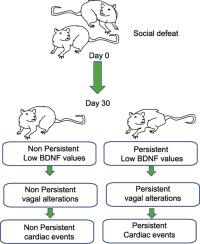Neurobiology of Stress ( IF 5 ) Pub Date : 2020-08-03 , DOI: 10.1016/j.ynstr.2020.100245 Charly Brouillard , Pascal Carrive , Caroline Sévoz-Couche

|
Previously, a sub-population of defeated anesthetized rats (Dlow) was characterized by persistent low blood levels of brain-derived neurotrophic factor (BDNF) at day 29 and autonomic alteration at day 30 after social challenge, while the other population (Dhigh) was similar to non-defeated (ND) animals. The aims of this study were to determine the time-course of autonomic dysfunction in awake animals, and whether Dhigh and/or Dlow were vulnerable to cardiac events. Defeated animals were exposed to four daily episodes of social defeats from day 1 to day 4. At day 30, anesthetized Dlow displayed decreased experimental and spontaneous reflex responses reflecting lower parasympathetic efficiency. In addition, Dlow but not Dhigh were characterized by left ventricular hypertrophy at day 30. Telemetric recordings revealed that Dlow had increased low frequency-to-high frequency ratio (LF/HF) and diastolic (DBP) and systolic (SBP) blood pressure, associated with decreased HF and spontaneous baroreflex responses (BRS) from day 3 to day 29. LF/HF, DBP and SBP recovered at day 5, and HF and BRS recovered at day 15 in Dhigh. Ventricular premature beats (VPBs) occurred in Dlow and Dhigh animals from day 5. Time course of VBP fluctuations in Dhigh mirrored that of HF and BRS, but not that of LF/HF, DBP and SBP.
These results suggest that a psychosocial stress associated to low serum BDNF levels can lead to vulnerability to persistent autonomic dysfunction, cardiac hypertrophy and ventricular ectopic beats. The parasympathetic recovery seen in Dhigh may provide protection against cardiac events in this population.
中文翻译:

社交失败:迷走神经减少和易患室性心律失常
以前,麻醉失败的老鼠亚群(Dlow)的特征是在社交攻击后第29天持续低血脑源性神经营养因子(BDNF),在社交挑战后第30天出现自主神经改变,而其他人群(Dhigh)则是与不败(ND)动物相似。这项研究的目的是确定清醒动物的自主神经功能障碍的时程,以及Dhigh和/或Dlow是否易受心脏事件的影响。从第1天到第4天,被击败的动物每天都会遭受4次社交失误的发作。在第30天,麻醉的Dlow表现出降低的实验性和自发性反射反应,反映出较低的副交感效率。另外,第30天Dlow但Dhigh的特征不是左室肥大。遥测记录显示,Dlow从第3天到第29天,低频与高频比(LF / HF)和舒张压(DBP)和收缩压(SBP)升高,与HF降低和自发性压力反射反应(BRS)相关。 Dhigh的LF / HF,DBP和SBP在第5天恢复,HF和BRS在第15天恢复。从第5天开始,在Dlow和Dhigh动物中发生室性早搏(VPB)。Dhigh中VBP波动的时程与HF和BRS的相似,但与LF / HF,DBP和SBP的相似。
这些结果表明,与低血清BDNF水平相关的社会心理压力可能导致对持续的自主神经功能障碍,心脏肥大和心室异位搏动的脆弱性。Dhigh出现的副交感神经恢复可能为该人群的心脏事件提供了保护。



























 京公网安备 11010802027423号
京公网安备 11010802027423号